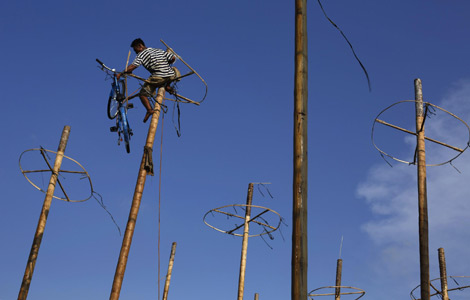Basic facts about Indonesia
Updated: 2013-10-02 13:35
(Xinhua)
|
||||||||
BEIJING - President Xi Jinping left Beijing on Wednesday morning for state visits to Indonesia, Malaysia, and the 21st leaders' meeting of the Asia-Pacific Economic Cooperation (APEC).
The following are some key facts about Indonesia:
The Republic of Indonesia is located in Southeast Asia near the equator, comprising 17,508 islands with a total land area of 1.9 million square km. It is the largest archipelagic nation as well as the fourth most populous country in the world with a population of more than 238 million in 2010. Its capital is Jakarta.
Indonesia is a multinational country composed of more than 100 ethnic groups. Javanese account for 45 percent of the population, and Sundanese 14 percent. The country's official language is Indonesian, but also spoken are more than 200 minority languages. It has the world's largest number of Muslims which make up 87 percent of the country's population.
Indonesia has abundant natural resources, including crude oil, natural gas, coal, tin, bauxite, nickel, copper, gold, and silver. It is the largest economy in Southeast Asia, with cash crop growing, export-oriented manufacturing and service industries as the pillar of its economy. The country is world's second largest producer of palm oil, rubber, and pepper. In recent years, its manufacturing has registered a faster growth than its national economy as a whole.
Tourism ranks the second among all non-oil and gas foreign exchange earners. The Indonesian government has given high priority to developing tourist attractions, building hotels, training practitioners and simplifying border entry procedures.
Indonesia has pursued an independent and non-aligned foreign policy. It is a founding member of the Association of Southeast Asian Nations (ASEAN), and has regarded ASEAN as a cornerstone in implementing its foreign policy.
The country is committed to practical regional cooperation while maintaining balanced ties with great powers, such as the United States, China, Japan, Australia, and the European Union. It seeks their political support and economic aid, while laying emphasis on the Non-Aligned Movement and South-South cooperation.
Indonesia and China established diplomatic ties on April 13, 1950. The ties were broken off on October 30, 1967 and then restored on August 8, 1990. Since then the two countries have experienced rapid development of bilateral ties.
In 2005, China and Indonesia signed a joint declaration, which designated their relations as "strategic partners," pushing their bilateral ties to a new stage of all-round development.
With bilateral trade reaching $66.22 billion last year, China has become Indonesia's second biggest trading partner. Bilateral trade in the first half of 2013 hit 33.84 billion dollars, up 4.6 percent from the same period of last year.

 Travel becomes passport to a new look
Travel becomes passport to a new look
 Impasse in Congress shuts down services
Impasse in Congress shuts down services
 Li, Serena cruise on, Venus out at China Open
Li, Serena cruise on, Venus out at China Open
 Portrait of an amateur Waltz dancer
Portrait of an amateur Waltz dancer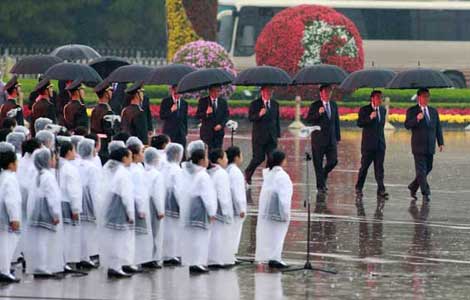
 Honoring heroes at Tian'anmen Square
Honoring heroes at Tian'anmen Square
 14 fishermen rescued, 2 dead, 58 missing after typhoon
14 fishermen rescued, 2 dead, 58 missing after typhoon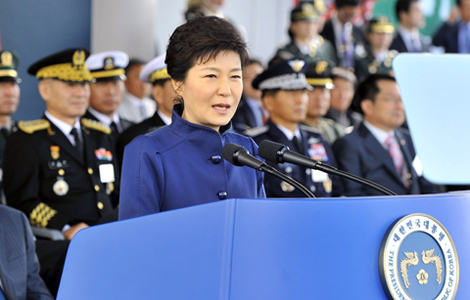
 ROK urges deterrence against DPRK's nuke threats
ROK urges deterrence against DPRK's nuke threats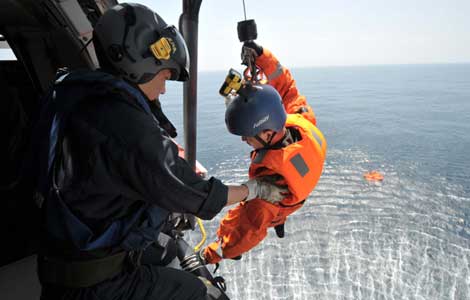
 Search for fishermen continues
Search for fishermen continues
Most Viewed
Editor's Picks

|

|

|
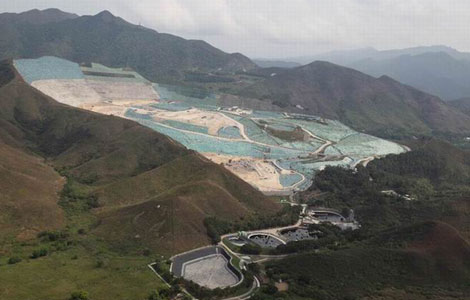
|

|

|
Today's Top News
Chinese invest in Vermont
Haier's stake sale a boost
Impasse in Congress shuts down services
US big 3 automakers sales slowdown
Market in antiques booms in Shanghai
Manufacturing shows positive growth
Beijing to issue air quality warnings
China's railways see record traffic
US Weekly

|

|


